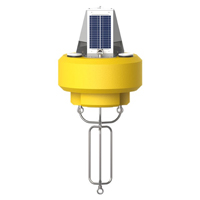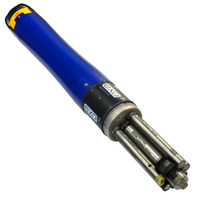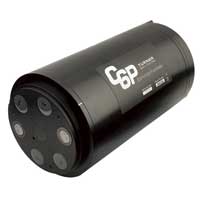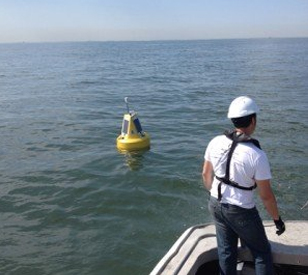 Launched during the height of summer off the Michigan coast, two Lake Erie buoys serve as testing platforms for new sensor technology that may one day become commonplace in tracking harmful algal blooms. Researchers at the National Oceanic and Atmospheric Administration’s Great Lakes Environmental Research Lab are behind the new tech, which includes experimental wind and phosphorus sensors.
Launched during the height of summer off the Michigan coast, two Lake Erie buoys serve as testing platforms for new sensor technology that may one day become commonplace in tracking harmful algal blooms. Researchers at the National Oceanic and Atmospheric Administration’s Great Lakes Environmental Research Lab are behind the new tech, which includes experimental wind and phosphorus sensors.
Data from the new sensors are important both for proving their usefulness in lake monitoring applications and for figuring out how phosphorus levels are influenced by the wind. Despite the fact that most phosphorus runoff going into Lake Erie comes from agriculture, scientists know that wind plays an important role in spreading the algae-feeding nutrient around.
The real power of the new monitoring platforms is their ability to provide scientists with real-time measurements of algae events and the effects of wind that can amplify blooms. With that type of immediate knowledge, researchers can respond to spikes in phosphorus they see by going out to the buoys and taking spot samples to confirm that the experimental sensors are reporting accurate information.
All-in-one testing platform
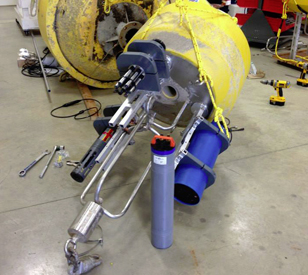 Two NexSens Technology CB-450 data buoys were chosen for the deployment, as scientists involved with the project wanted stable platforms with enough flexibility to accommodate their equipment. The CB-450 buoys were the ideal choice because they come with integrated solar panels for powering the new sensing devices and provide an instrument well to house anything the researchers needed – like extra batteries, data loggers or communications equipment.
Two NexSens Technology CB-450 data buoys were chosen for the deployment, as scientists involved with the project wanted stable platforms with enough flexibility to accommodate their equipment. The CB-450 buoys were the ideal choice because they come with integrated solar panels for powering the new sensing devices and provide an instrument well to house anything the researchers needed – like extra batteries, data loggers or communications equipment.
The NexSens-designed buoys also have features that were required for project success, like a top plate for mounting beacons or sensors that scientists used to support the experimental wind devices. The buoys feature removable tops, so equipment deployed within each was easy for project managers to access for maintenance. Top-to-bottom sensor ports on the CB-450s also provide a safe location for installing water quality devices, like YSI Multi-Parameter Water Quality Sondes that allowed researchers to gather data on temperature, conductivity, pH, dissolved oxygen and turbidity.
Alongside the sondes sat Wetlabs CYCLE P Phosphorus sensors and Turner Designs’ optical sensors that measure concentrations of plant pigments. Those data relate to algae productivity and help researchers tell if any toxic cyanobacteria are nearby.
The NexSens CB-450 Data Buoy is designed for deployment in lakes, rivers, coastal waters, harbors, estuaries and other freshwater or marine environments.
The YSI EXO represents the next generation of water quality instruments from YSI. The EXO2 sonde includes six sensor ports and a central anti-fouling wiper option.
The C6P Submersible Fluorometer can be configured with up to six optical sensors ranging from the deep ultraviolet to the infrared spectrum.

